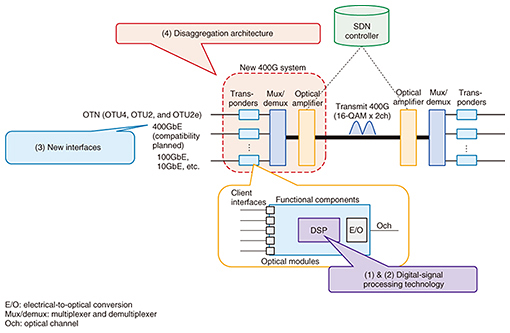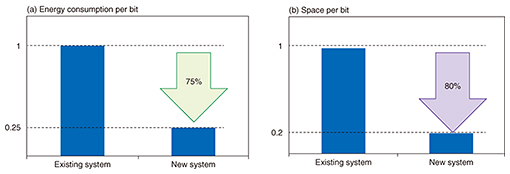 |
|
|
|
|
|
Short Reports Vol. 15, No. 7, pp. 56–58, July 2017. https://doi.org/10.53829/ntr201707sr2 NTT Communications to Deploy 400-Gbit/s Optical Transmission System for Datacenter Network Connections1. IntroductionNTT Communications Corporation (NTT Com), the information and communication technology solutions and international communications business within the NTT Group, began deploying an ultralarge-capacity, space-saving, and energy-saving 400-Gbit/s (400G) optical transmission system in datacenters for network connection on April 14, 2017. The system raised the transmission capacity of NTT Com’s core network above 19 Tbit/s per optical fiber, or more than double the existing capacity. The system utilizes advanced digital-signal processing technology, which is the result of NTT’s research and development (R&D). 2. BackgroundNTT Com achieved its existing 100-Gbit/s-per-channel optical transmission system through the early adoption of digital coherent optical transmission technology in response to rapidly increasing traffic on its core optical fiber network, as well as expanding video data and cloud services. NTT Com has now taken practical steps to upgrade transmission technology to 400G due to ever-increasing network demands for higher speeds and more data, including for 4K/8K and other high-resolution video data, the full-fledged expansion of the Internet of Things, and big-data processing. 3. Features and advantages of 400G systemThe main features and advantages of the 400G system, as depicted in Fig. 1, are described here.
(1) Top-level energy and space saving (Fig. 2) The new system reduces energy consumption per bit by 75% and space requirements by 80% compared to the existing system. The savings were achieved through a synergistic combination of advanced digital-signal processing technology and 16-nm CMOS (complementary metal-oxide semiconductor) technology. Energy-saving integrated circuits can be constructed rapidly, enabling systems to be quickly deployed even in confined spaces at datacenters.
(2) Higher transmission capacity The new system achieves more than double the transmission capacity per optical fiber compared to its predecessor system. To generate 400G signals, the system utilizes NTT’s research result: 16-quadrature amplitude modulation (QAM) for both phase and amplitude, and sub-carrier multiple transmission. (3) New optical transport network (OTN) and 400-Gbit/s Ethernet (400GbE) interfaces In connection with the deployment, NTT Com will offer new optional network services for enterprises, including the sequential launch of OTN interfaces (optical-channel transport unit (OTU)2, OTU2e, and OTU4) primarily for wholesalers and datacenter users, and a 400GbE interface incorporating framing technology compatible with OTUCn, which is the result of NTT’s R&D. (4) Disaggregation architecture To deliver new services and functions with even greater speed and flexibility, NTT Com will combine software-defined networking (SDN) technologies and disaggregation architecture, which can be redeployed as required according to function or module, replacing existing high-function, all-in-one dedicated equipment. Going forward, NTT Com and NTT will jointly investigate further possibilities, including the proof of concept deployment to deliver high-speed Ethernet signals, including 400GbE. Mindful of IEEE (Institute of Electrical and Electronics Engineers) standardization trends, they will pursue increased flexibility and agility for transmission networks by leveraging disaggregated equipment and SDN technologies. For InquiriesInnovation Division, Customer Services Department, NTT Communications CorporationEmail: aline-si@ntt.com Public Relations Section, Planning Department, NTT Information Network Laboratory GroupEmail: inlg-pr@lab.ntt.co.jp |
|










